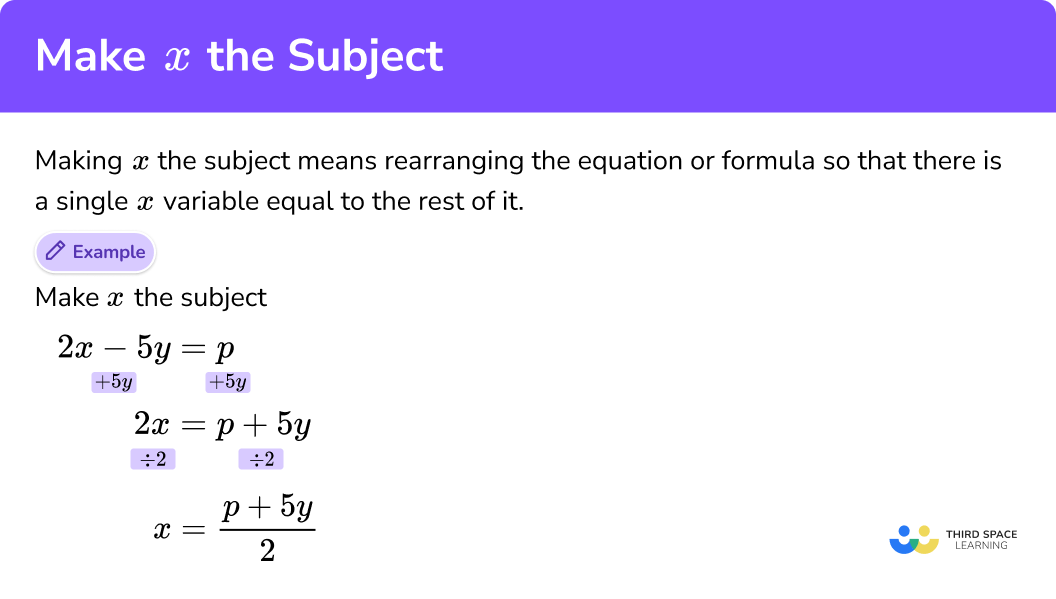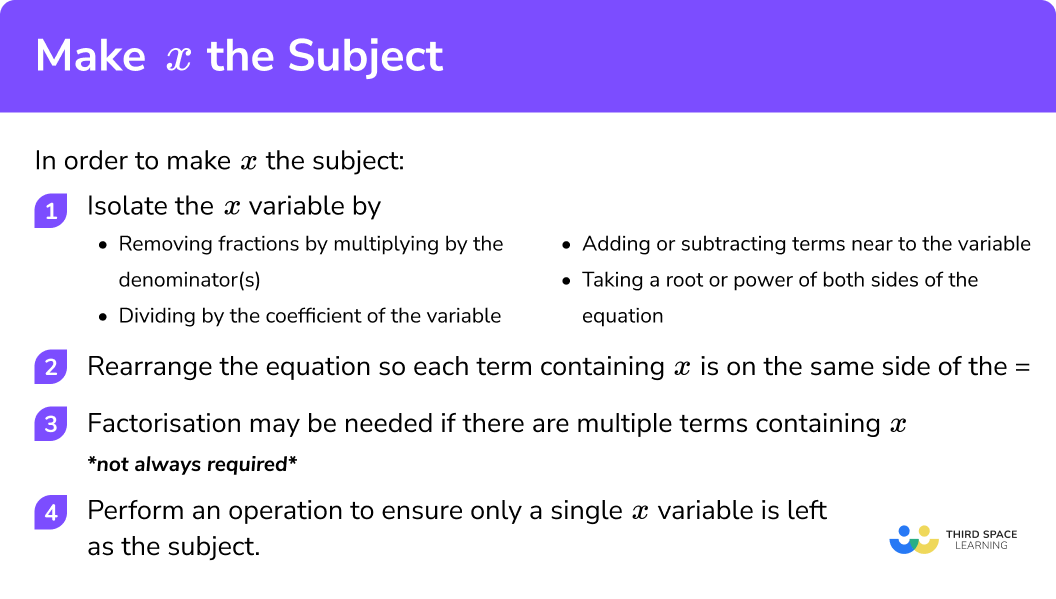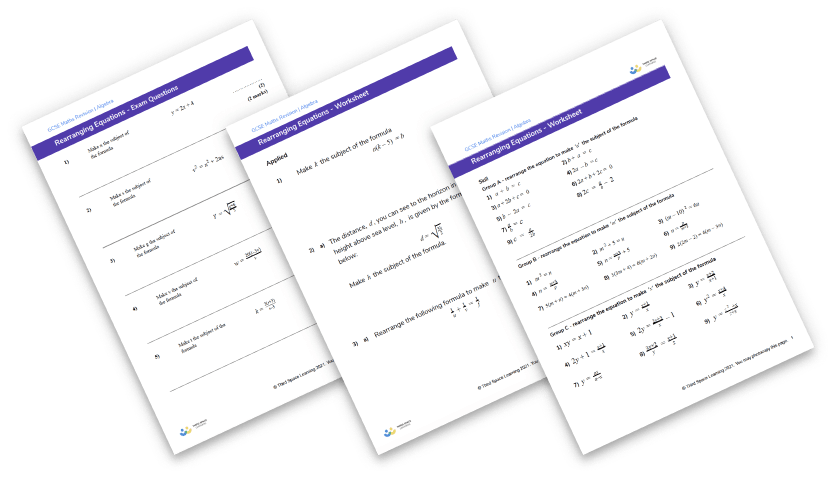One to one maths interventions built for KS4 success
Weekly online one to one GCSE maths revision lessons now available
In order to access this I need to be confident with:
Expanding brackets Factorising Solving equationsThis topic is relevant for:

Make x The Subject
Here we will learn about making
There are also rearranging equations worksheets based on Edexcel, AQA and OCR exam questions, along with further guidance on where to go next if you’re still stuck.
What does it mean to make x the subject?
Making
For example,
Make
Step-by-step guide: Rearranging equations
What does it mean to make x the subject?

How to make x the subject
In order to make
- Isolate the variable by:
– Removing any fractions by multiplying by the denominator(s).
– Dividing by the coefficient of the variable.
– Adding or subtracting terms near to the variable.
– Taking a root or power of both sides of the equation. - Rearrange the equation so each term containing
x is on the same side of the =. - Factorisation may be needed if there are multiple terms containing
x .
E.g. factorise2x + 3xy tox(2+3y)
*not always required* - Perform an operation to ensure only a single
x variable is left as the subject.
Explain how to make x the subject in 4 steps


Make x the subject worksheet

Get your free make x the subject worksheet of 20+ questions and answers. Includes reasoning and applied questions.
DOWNLOAD FREE
Make x the subject worksheet

Get your free make x the subject worksheet of 20+ questions and answers. Includes reasoning and applied questions.
DOWNLOAD FREEMake x the subject examples
Example 1: multiple step but with single variable
Make
Step 1:
Divide each side of the equation by 3
Step 2:
Subtract a from each side of the equation
Example 2: questions involving x2
Step 1:
Subtract t from both sides of the equation
Step 2:
Square root each side
Remember the square root can be + or \;−
Example 3: questions involving √x
Step 1:
Add 9a to both sides of the equation
Step 2:
The inverse operation of ‘square root’ is to ‘square’ each side
Step 3:
The inverse operation of multiply is divide, so divide both sides by 5
Example 4: factorisation of the variable is required
Step 1:
Multiply each side of the equation by the denominator
Step 2:
Expand the bracket on the left hand side of the equation and rearrange the equation. This will help us to get all terms with x onto one side of the equation
Step 3:
Factorise the left side of the equation so we have a single variable x.
Step 4: Divide by (a - 5b)
This will leave x as the subject of the equation
Example 5: factorisation of the variable is required
Step 1:
Multiply each side of the equation by the denominator of the other side.
Step 2:
Expand the bracket on the LHS and RHS of the equation and rearrange. This will help to get all terms with x onto one side of the equation
Step 3:
Factorise the left side of the equation so that we are left with only one of the variable x.
Step 4:
Divide both sides by (b + 8) to leave x as the subject
Common misconceptions
- Perform the same operation to both sides
When we perform an operation to the left hand side of the equation we have to perform the same operation to the right hand side.
E.g
To isolate the variable
This is wrong because we have only multiplied the
The correct answer should be:
This is correct because we have multiplied everything by 2 using brackets.
- Inverse operations
E.g.
To isolate the variable
E.g.
so the inverse operation is × 5.
E.g.
To isolate the variable
The inverse operation of +5 is −5.
E.g.
To isolate the variable
The inverse operation of −5 is +5.
- Factorising
To make
E.g.
- Square rooting a term
When we square rooting a number/variable as an inverse operation the answer can be positive or negative.
E.g.
Practice make x the subject questions
1.Make x the subject of the formula.
y = 6(x+8)
x = y – \frac{3}{4}

x = \frac{y}{6} + 8

x = \frac{y}{6} – 8

x = y – 8

Divide both sides by 6
\frac{y}{6} = x + 8
Then subtract 8 from both sides
x = \frac{y}{6} – 8
2.Make x the subject of the formula.
3p={x}^2-4b
x=\pm\sqrt{3b+4p}

x=\pm\sqrt{4b-3p}

x=4b+3p

x=\pm\sqrt{4b+3p}

3p={x}^2-4b
Add 4b to both sides
3p+4b=x^{2}
Square root both sides
x=\pm\sqrt{4b+3p}
3. Make x the subject of the formula.
6g=\sqrt{7x-8}
x=\frac{6{g}^2+8}{7}

x=\frac{36{g}^2-8}{7}

x=\frac{36{g}^2+8}{7}

x=\frac{6g+8}{7}

6g=\sqrt{7x-8}
Square both sides
(6g)^{2}=(\sqrt{7x-8})^{2}
36g^{2}=7x-8
Add 8 to both sides
36g^{2}+8=7x
Divide both sides by 7
x=\frac{36{g}^2+8}{7}
4.Make x the subject of the formula.
y=\frac{4x-f}{5x}
x=\frac{f}{5y-4}

x=\frac{-f}{5y+4}

x=\frac{f}{5y+4}

x=\frac{-f}{5y-4}

y=\frac{4x-f}{5x}
Multiply both sides by 5x
5xy=4x-f
Subtract 4x from both sides
5xy-4x=-f
Factorise the left hand side
x(5y-4)=-f
Divide both sides by the quantity in the bracket
x=\frac{-f}{5y-4}
5. Make x the subject of the formula.
\frac{y}{3}=\frac{6-2x}{x+3}
x=\frac{18+3y}{y+6}

x=\frac{18-3y}{y-6}

x=\frac{18-3y}{y+6}

x=\frac{18+3y}{y-6}

\frac{y}{3}=\frac{6-2x}{x+3}
Multiply each side of the equation by the denominator of the other side.
xy+3y=18-6x
To both sides, add 6x and subtract 3y
xy+6x=18-3y
Factorise the left hand side
x(y+6)=18-3y
Divide by the quantity in the bracket
x=\frac{18-3y}{y+6}
Make x the subject GCSE Questions
1. Make x the subject of the formula
y=5x-7
(2 marks)
y+7=5x
(1)
\frac{y+7}{5} = x
(1)
2. Make x the subject of the formula
z^{2}=x^{2}-5 a y
(2 marks)
z^{2}+5 a y=x^{2}
(1)
\pm\sqrt{z^{2}+5 a y}=x
(1)
3. Make x the subject of the formula
y=\frac{3(t+5 x)}{x}
(4 marks)
y x=3 t+15 x
(1)
y x-15 x=3 t
(1)
x(y-15)=3 t
(1)
x=\frac{3t}{y-15} \quad
(1)
Learning checklist
You have now learned how to:
- Understand and use standard mathematical formulae
- Rearrange formulae to change the subject
The next lessons are
Still stuck?
Prepare your KS4 students for maths GCSEs success with Third Space Learning. Weekly online one to one GCSE maths revision lessons delivered by expert maths tutors.

Find out more about our GCSE maths tuition programme.